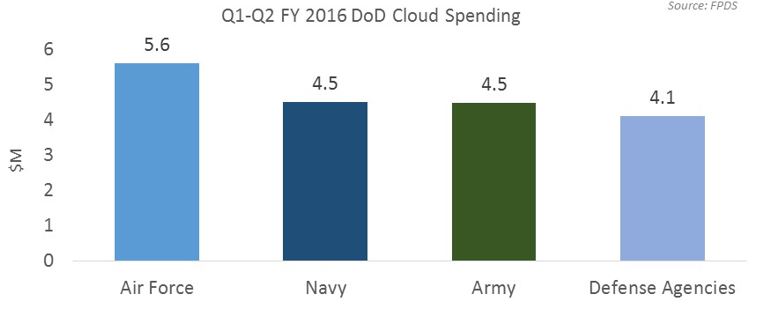Defense Cloud Spending in Q1 and Q2 of FY 2016
Published: November 30, 2016
USAFARMYCloud ComputingForecasts and SpendingInformation TechnologyNAVYOSD
Defense spending on cloud computing appears to be slowing.
A few weeks back I posted some analysis of cloud computing contract awards made in fiscal year 2016. The data provided at that time was preliminary, containing no numbers showing contract spending. Only the total value of a small number of awarded contracts was provided. Today’s post partially remedies the lack of cloud contract spending in the previous post by providing an analysis of data reported by the Department of Defense for spending on cloud computing over the first two quarters of FY 2016.
First, just the Q1-Q2 FY 2016 data itself. The chart below breaks down this spending by defense entity.
Air Force led the way among all defense components and military departments by spending nearly $6M from 1 October 2015 to 31 March 2016. Readers are advised to keep in mind that this data is for spending on cloud requirements which could be easily identified. There is always a larger amount of spending that cannot be easily identified. For example, Deltek keeps a database of contracts that are verified to be cloud-related work. Pulling obligations data for those contracts is extremely labor intensive and reserved for our big cloud market analysis effort published every October. Reported spending on those contracts has not been included here, so consider the numbers presented as minimum spending only.
Comparing total DoD spending on cloud from FY 2013 through FY 2015 with the first two quarters of FY 2016 shows the following.
DoD’s overall spending on cloud has been on something of a roller coaster the last few years. Averaging those ups and downs from FY 2013 to FY 2015 gives us a figure of $199M spent annually. Assuming the final tally of DoD’s cloud spending in FY 2016 approaches that of at least FY 2013, the total that DoD spent in FY 2016 will end up being somewhere north of $160M.
I know what readers are thinking. This assumption means that in the latter half of FY 2016, the DoD will have had to spend at least $150M on cloud and that’s a lot of money in only 5 months (April-September). DoD spending that amount is conceivable, but remember the partial data issue I described above. FY 2016’s first half total is based only on cloud obligations that are readily identifiable. The number does not include spending on verified cloud contracts (the harder to compile spending) that were still active going into the fiscal year.
This caveat aside, easily identified cloud spending at DoD in FY 2016 came distinctly weaker than I had anticipated when I began this analysis. Why might this be? The implementation of different cloud strategies across the DoD is probably a big reason. The lack of clarity about how to move forward, as well as the slow business of standing up cloud brokers, writing governance documents, developing formal strategies, and competing contracts for cloud requirements are undoubtedly contributing to slow cloud spending across the department.
What the evidence appears to illustrate is a massive federal department turning very slowly toward a new technology. These transitions take time, especially when it is one of the largest organizational entities in the world making the shift. Add to this the ponderous nature of the federal procurement system. Not a day passes without federal officials and/or Congress blasting the tortoise-like nature of U.S. government technology buying. I have a sneaking suspicion that the slowness of federal procurement is a contributing factor to the DoD’s low cloud spending numbers. The DoD never adopts new technologies quickly or easily and the cloud spending data presented here appears to prove that beyond a doubt.

